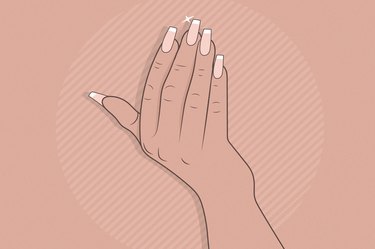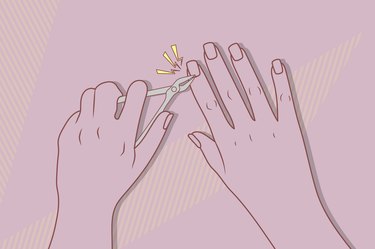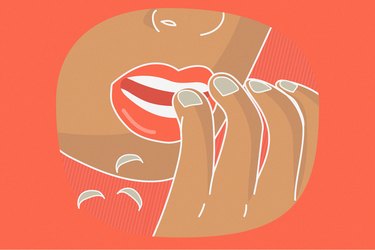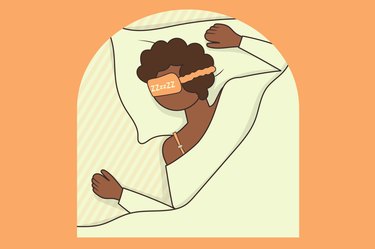
Acrylic nails can be a fun way to dress up your look or express your sense of style. And while you may love the look of them, you may also wonder: Are acrylics bad for you? And do they damage your real nails?
Here's what you should know about the effects of acrylics and how to keep your nails healthy if you get them done often.
Video of the Day
Video of the Day
How Acrylics Affect Your Nails and Skin
The very act of adhering acrylics to your natural nail requires some damage, but these nails can also invite poor nail habits at home.
1. Your Real Nails Need to Be 'Roughed Up' for Application
The mixture your nail tech will blob onto your nails to create your new set won't stick on your regular nail — your nails need to be "roughed up" first by filing down their surface.
"This creates mechanical damage and thinning of the nail plate," Christina Chung, MD, board-certified dermatologist at Schweiger Dermatology Group in Philadelphia, tells LIVESTRONG.com.
2. Chemicals in Acrylics Can Cause Skin Reactions
It's possible to be allergic to the liquid/powder mixture that makes up acrylics, and when theis touches your skin, you can experience itchiness and red and flaky skin on the fingers, hands and wrist — and even on your face and neck, according to March 2020 research in the International Journal of Women's Dermatology.
If your hands itch or burn after acrylic application, that's a sign of a reaction. You'll probably need to have them removed and look into alternative mani options.
Allergic reactions may be immediate but can also take days to appear. One of the most common causes of eyelid dermatitis is from allergic contact dermatitis to nail products.
3. Picking Them Creates Problems
Unfortunately, people also tend to pick and peel at their nails when they have acrylics. It's totally normal, but not healthy for your nails, as doing so only exacerbates damage, Dr. Chung says.
Need visual proof? One May 2022 case study in Cureus of a 67-year-old woman who was a habitual acrylic nail picker shows what happens when you peel them off. Namely, pieces of your nail plate can become stuck to the underside of the acrylic, weakening your nails.
4. Touch-Ups Also Bring Trauma
While they may last for six to eight weeks, you'll need to get acrylic nails touched up every two to three weeks if you want to maintain them. It's at that interval when you'll notice they've begun to grow out and your acrylics will look like they're migrating upward, as there will be a gap between your cuticle and where the acrylics start. Now, you need a fill. So, you'll need to go back to the nail salon to get the base filled in and the tips filed down and reshaped.
Unfortunately, this touch-up process also creates additional nail damage and brittleness, Dr. Chung says.
5. They Can Crack or Fracture Your Nails
The good thing about acrylics: They're hard, tough nails. The bad thing about acrylics: They're hard, tough nails, Dr. Chung says. Meaning: "They can crack and fracture your nails," she says.
The bond adhering the acrylic to your nail plate tends to be stronger than what keeps the nail plate attached to the nail bed (your skin), suggests the March 2020 research in the International Journal of Women's Dermatology. As a result, your nail can separate from the skin.
In addition, acrylics disrupt the hydration balance in your natural nail, making them more likely to pull away from the nail bed. (Ouch!)
Can Acrylic Nails Cause Cancer?
You may have read that acrylic nails are toxic or cause cancer. It's true that some acrylic nail products may contain chemicals linked to cancer, such as benzene or formaldehyde, but the research has been mixed around whether getting your nails done ups your risk for the disease.
It's also true that exposure to UV light — sometimes used in the drying process — is linked to cancer, but the risk of getting the disease from frequent visits to the nail salon is very low, according to a July 2014 research letting in JAMA Dermatology. Still, the authors recommend wearing sunscreen to lower your exposure.
Tips for Keeping Nails Healthy With Acrylics
1. Remove Them the Right Way
When the set has reached the end of its life, nails need to be soaked in acetone and filed off. This removal process "creates even more trauma" to nails, Dr. Chung says.
Still, professional removal is the way to go when you have acrylics. Remember, you should not peel them off on your own.
2. Give Your Nails a Rest
Consecutive cycles of acrylic nails can be especially damaging, as nails should be allowed to "breathe." Take a break or reserve acrylics for special occasions only, suggests the American Academy of Dermatology, which points out that this allows nails ample time for repair.
3. Take Care of Your Hands
No matter what type of manicure you're getting, it's important to practice proper nail health habits, says Dr. Chung. That means keeping nails and the surrounding skin moisturized by drinking enough water, applying a cream or ointment on hands and protecting them with gloves when washing dishes or cleaning. This goes for whether you're wearing acrylics or sporting your natural nail.
Cuticle care is also important. Try to avoid cuticle trimming as much as possible, and ask your nail technician not to push or excessively trim your cuticles. This helps to protect your nails and decreases the risk of infection.
Gel Nails vs. Acrylic Nails
A gel manicure uses a gel polish that’s set on your real nail with a UV light, while acrylics are a type of artificial nail made with a liquid-powder mixture that becomes a paste that’s then applied on top of your natural nail (with or without a tip extension added) and shaped into your specific style — round, almond, coffin, stiletto, etc.
A gel manicure is not without its risks, but Dr. Chung recommends it as a healthier alternative, as gel can be removed in a gentler manner (soaking in acetone) rather than soaking and filing, and the nail plate doesn’t have to be roughed up during application.
So, How Bad Is It Really to Get Acrylic Nails?
Acrylics are beautiful, but wearing them is not great for the overall health of your nails.
If you're going to wear acrylics, it's best to do so only occasionally for something special. Make sure to take proper care of your nails by resisting picking or peeling them and getting them removed professionally by a nail tech.
- Scher and Daniel’s Nails: “Nail Cosmetics: Benefits and Pitfalls”
- American Academy of Dermatology: “Artificial Nails: Dermatologists’ Tips for Reducing Nail Damage”
- Cureus: "Nailing the Diagnosis: Onychotillomania in Patients With Artificial Nails—An Underrecognized Phenomenon?"
- International Journal of Women’s Dermatology: "Nail Health in Women"
- JAMA Dermatology: "Further Investigation Into the Risk of Skin Cancer Associated With the Use of UV Nail Lamps"
Is this an emergency? If you are experiencing serious medical symptoms, please see the National Library of Medicine’s list of signs you need emergency medical attention or call 911.



